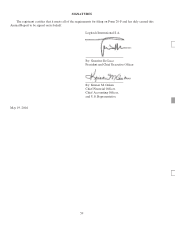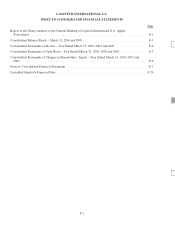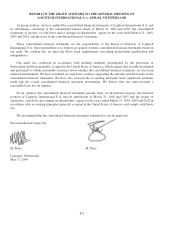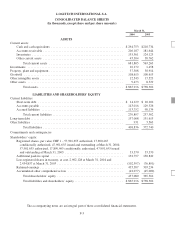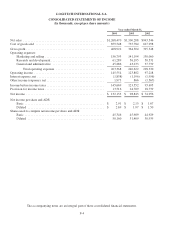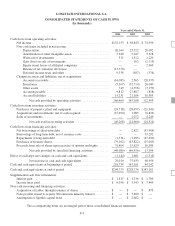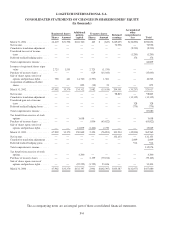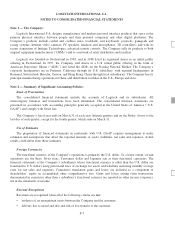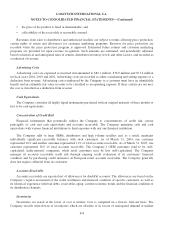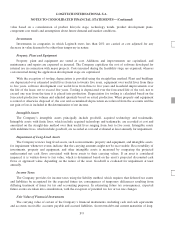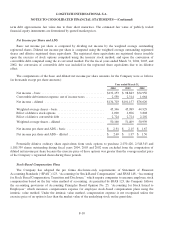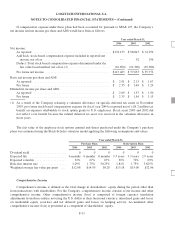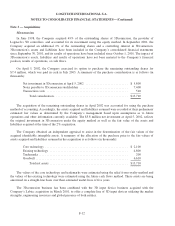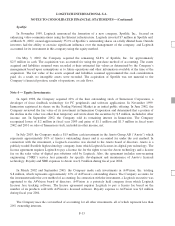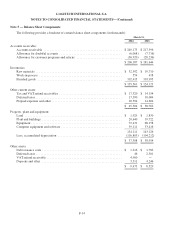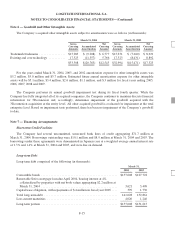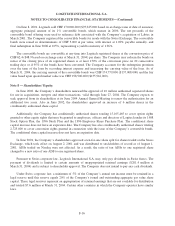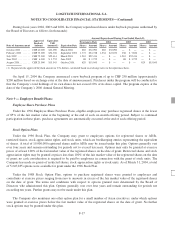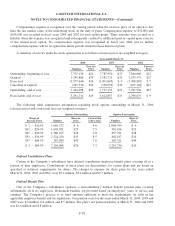Logitech 2004 Annual Report Download - page 107
Download and view the complete annual report
Please find page 107 of the 2004 Logitech annual report below. You can navigate through the pages in the report by either clicking on the pages listed below, or by using the keyword search tool below to find specific information within the annual report.
LOGITECH INTERNATIONAL S.A.
NOTES TO CONSOLIDATED FINANCIAL STATEMENTS—(Continued)
term debt approximates fair value due to their short maturities. The estimated fair value of publicly traded
financial equity instruments are determined by quoted market prices.
Net Income per Share and ADS
Basic net income per share is computed by dividing net income by the weighted average outstanding
registered shares. Diluted net income per share is computed using the weighted average outstanding registered
shares and dilutive registered share equivalents. The registered share equivalents are registered shares issuable
upon the exercise of stock options computed using the treasury stock method, and upon the conversion of
convertible debt computed using the if-converted method. For the fiscal years ended March 31, 2004, 2003, and
2002, the conversion of convertible debt was included in the registered share equivalents due to its dilutive
effect.
The computations of the basic and diluted net income per share amounts for the Company were as follows
(in thousands except per share amounts):
Year ended March 31,
2004 2003 2002
Net income – basic ........................................ $132,153 $ 98,843 $74,956
Convertible debt interest expense, net of income taxes ............ 2,550 2,314 1,664
Netincome–diluted ...................................... $134,703 $101,157 $76,620
Weighted average shares – basic ............................. 45,346 45,989 44,929
Effect of dilutive stock options .............................. 2,090 2,696 3,808
Effect of dilutive convertible debt ............................ 2,724 2,724 2,202
Weighted average shares – diluted ............................ 50,160 51,409 50,939
Net income per share and ADS – basic ........................ $ 2.91 $ 2.15 $ 1.67
NetincomepershareandADS–diluted....................... $ 2.69 $ 1.97 $ 1.50
Potentially dilutive ordinary share equivalents from stock options to purchase 2,070,426, 2,548,343 and
1,180,339 shares outstanding during fiscal years 2004, 2003 and 2002 were excluded from the computation of
diluted net income per share because the exercise price of these options was greater than the average market price
of the Company’s registered shares during these periods.
Stock-Based Compensation Plans
The Company has adopted the pro forma disclosure-only requirements of Statement of Financial
Accounting Standards (“SFAS”) 123, “Accounting for Stock-Based Compensation” and SFAS 148, “Accounting
for Stock Based Compensation, Transition and Disclosure,” which require companies to measure employee stock
compensation based on the fair value method of accounting. As permitted by SFAS 123, the Company follows
the accounting provisions of Accounting Principles Board Opinion No. 25, “Accounting for Stock Issued to
Employees” which measures compensation expense for employee stock-based compensation plans using the
intrinsic value method. Under the intrinsic value method, compensation expense is not recognized unless the
exercise price of an option is less than the market value of the underlying stock on the grant date.
F-10


